October 18, 2019
A New Wind in Mongolia
Janchiv Galbadrakh is a 56-year-old doctoral student at the Nagoya University Graduate School of Education and Human Development. His actual job is president of the New Mongol Academy, a private school in Mongolia made up of four institutions, including a combined elementary, middle and high school, an engineering college, and a technical college. The academy started out as a high school founded 19 years ago by Galbadrakh himself during his doctorate course at Tohoku University, because he wanted to bring Japanese-style education to Mongolia. In a rush to achieve this dream, he couldn't wait until his studies were finished. As a result, he didn't have time to write his doctoral thesis, and left the university without having earned a degree. After everything he has achieved over the years, he now wants to use his experience to spearhead education reform throughout Mongolia, and is challenging his doctorate again.
He chose Meidai because a school attached to its School of Education has exchanges with the New Mongol Academy, like student dispatches and shared lessons via video conferencing, and he got to learn that the Asian Satellite Campuses Institute's Transnational Doctoral Programs for Leading Professionals in Asian Countries -- a program that allows people to get their doctorates while working -- would be expanded into the field of education. He usually works in Ulaanbaatar and receives guidance via video conferencing, but comes to Meidai twice per year to receive guidance in person.
Last autumn he also became principal of the Shine (New) Mongol Harumafuji School, founded by former sumo wrestling yokozuna Kohei Harumafuji. His days are therefore extremely busy, but he is enthusiastic about compiling into his thesis the new educational advancements he achieved while learning from Japan over the past quarter century, when he first came as a 32-year-old exchange student.
Meidai and Mongolia have cooperated in a variety of ways up till now, but a new world is beginning to unfurl.
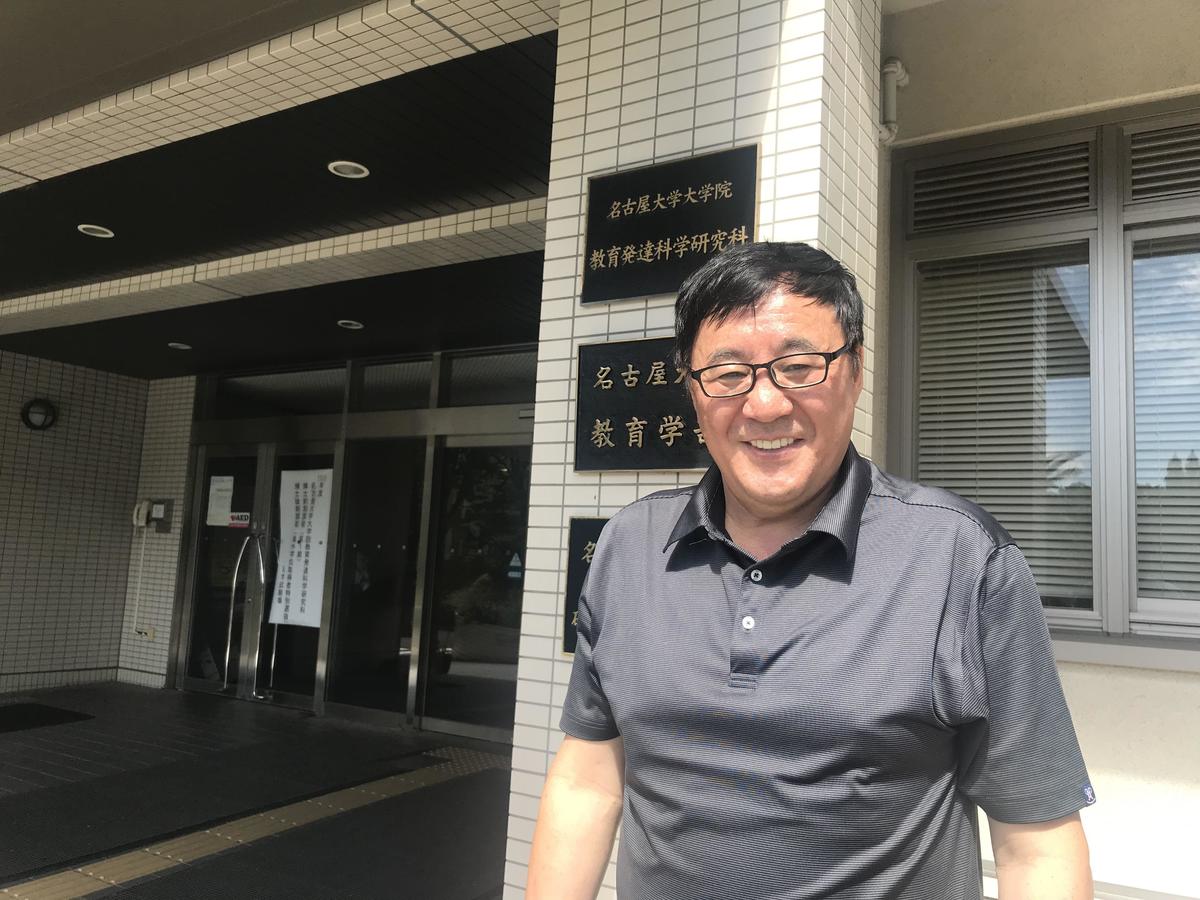 Janchiv Galbadrakh visited the Meidai campus at the beginning of September for his studies. His third-oldest daughter is currently also enrolled in the same postgraduate doctoral course. His motto is, “Bring the winds of Japan to Mongolian land.”
Janchiv Galbadrakh visited the Meidai campus at the beginning of September for his studies. His third-oldest daughter is currently also enrolled in the same postgraduate doctoral course. His motto is, “Bring the winds of Japan to Mongolian land.”
Just as with the founding of the school during his studies abroad, the life of Gal-san (his Japanese nickname) can seem like a series of challenges so bold, they sometimes could be considered reckless. It's undeniable that he is excited by a passion for education. Although he says he's felt regret more than once over his decision to start such a project, he was able to continue because each time there was "a wind blowing," that is, people who gave him a supportive push forward.
The first time was while he was enrolled in a master's course at Yamagata University. Gal-san had studied physics at the National University of Mongolia and became a teacher. After working at various schools, he applied to the former Japanese Ministry of Education's teacher training program and studied at Yamagata University for one year. Then after that, he decided to go on to do a master's degree on the topic of "Physics Education Development in Post-War Japan and an International Comparison." But "it was really a time of hardship," he says, as he not only had to pay tuition himself, but also struggled to support his family, having brought over his wife and four daughters to show them how developed Japan had become.
From 5 to 7am he delivered newspapers, and then helped his daughters study until 9am when he would go to university. When school was finished at 5pm, he would work at a shipping company until 8pm, then as a waiter at an izakaya restaurant until midnight. He decided to consider newspaper delivery like jogging, shipping work like exercises at a gym, and the work at the izakaya like Japanese language study, but sometimes asked himself why he had come to Japan. He got four hours of sleep per night. His wife also worked as a cleaner to help support the family.
Then came the opportunity of a writing competition for international students. The theme was "My Dream." Gal-san submitted an essay titled "Building a School," and it was selected for its excellence with an award of a 500,000 yen scholarship. His monthly income from three daily jobs was only 150,000 yen, so the generous sum was like a dream. He had actually only invented such a "dream" for the competition, but after his essay was selected he became serious about achieving it. He later also received a Rotary Club scholarship, and became determined to create a school to reward the kindness and good fortune.
But what kind of school to create? Gal-san felt that the key to Japan's development was its high-quality education, and that high school plays an especially large role. His eldest daughter had graduated from Yamagata Prefectural Nishi High School and got accepted into Tohoku University's School of Law, so he decided to make this high school his model. In order to create such a school, he started studying for his masters at Tohoku University on the topic of "Developing Senior High School Curriculum in Mongolia." He says he and his daughter became a local news item for both being Tohoku University students. A local volunteer organization was formed to provide financial support for Gal-san. Given a supportive push from behind, he travelled back and forth between Japan and Mongolia to acquire land and further plans for the school. Finally in May 2000 he succeeded in founding the Shine (New) Mongol High School, the country's first three-year Japanese-style high school.
But its operation was filled with challenges. He borrowed money, in addition to contributions from volunteers in Yamagata and Miyagi prefectures. The question "Why did I create a school?" sometimes crossed his mind. With the goal of fostering leaders who would support the nation, he introduced not only Japanese language education, but also Japanese-style education complete with uniforms, school lunches, and club activities. The first group of students graduated in March 2003, the same time Gal-san finished his doctoral course. Since then, of the total 1,850 graduates, 650 have gone on to flourish in studies abroad, including 424 at Japanese universities.
An elementary and middle school were also added in 2014, creating a combined elementary through high school. It is considered one of the best private schools in Mongolia, and with reasonable tuition fees, a popular school with a high barrier to entry. An engineering college, technical college, and preschool for early childhood education were successively founded, and the New Mongol Academy was established to integrate them, with Gal-san serving as the board chairman. Each school principal has studied abroad at a Japanese university, and operates their respective school following the example of their alma mater.
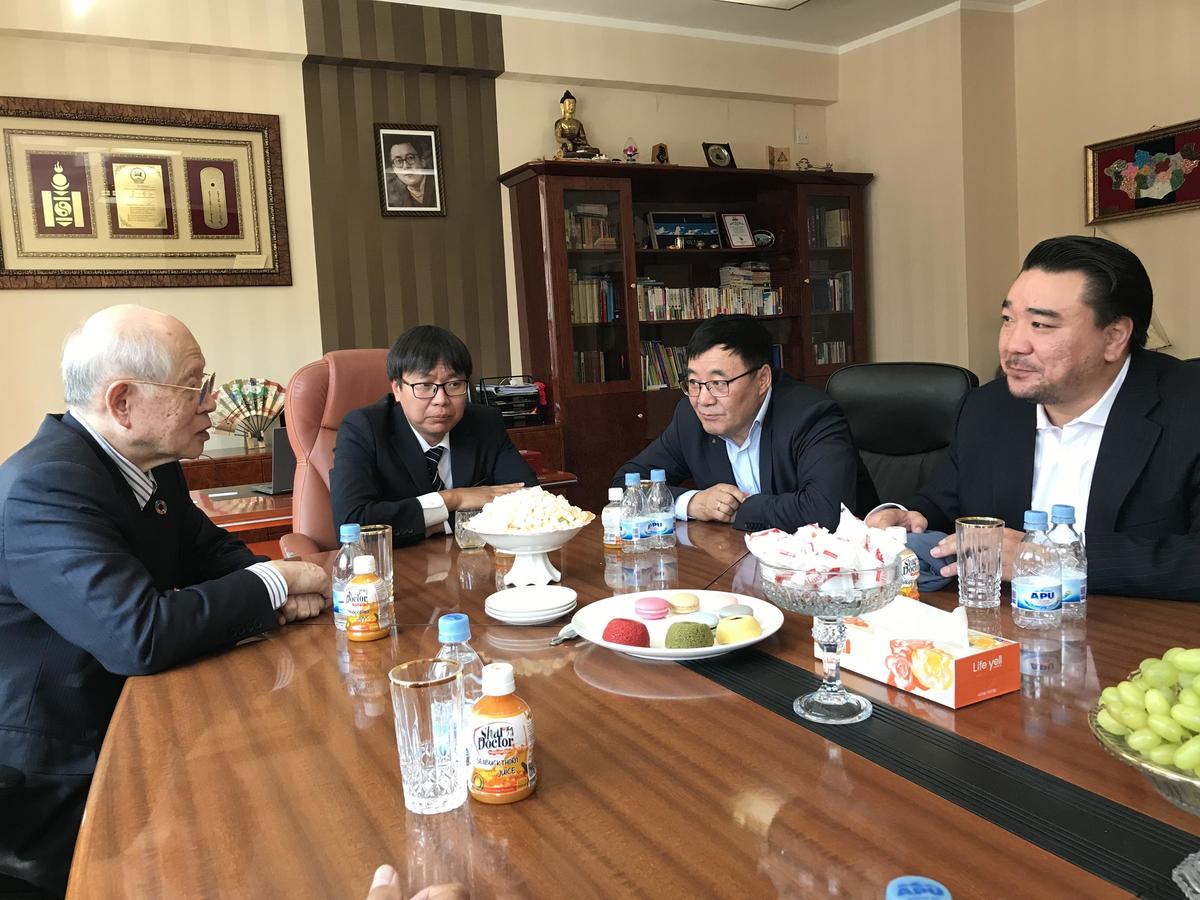 Principal Purevsuren Naranbayar (second from left), who welcomed Meidai’s University Professor Ryoji Noyori (left) upon his arrival at the Shine Mongol High School, is a graduate of Tokyo University of Foreign Studies and Kyoto University. To their right
Principal Purevsuren Naranbayar (second from left), who welcomed Meidai’s University Professor Ryoji Noyori (left) upon his arrival at the Shine Mongol High School, is a graduate of Tokyo University of Foreign Studies and Kyoto University. To their right
At the end of August, Meidai's University Professor Ryoji Noyori paid a visit to the Shine Mongol High School. He was by chance in Ulaanbaatar by invitation of the National University of Mongolia (NUM). "Shine Mongol High School" is written large on the school building in Japanese along with Mongolian, and Prof. Noyori was first shown to the pedestal that stands in front of the school. When alumni go on to become Nobel Prize Laureate or U.N. Secretary General, the school will place a statue of them there.
Harumafuji was also there to welcome the professor. He told Noyori, "I went to Japan when I was 16, and have since learned many things through sumo wrestling. I founded this school to help people in Mongolia prosper, as a way to give something back." According to Gal-san, Harumafuji began approaching him about creating a school three or four years ago, but he declined three times, saying it was no easy task. Harumafuji continued his appeal, however, and realizing his earnestness, Gal-san decided to help him create a combined elementary-middle-high school like the Shine Mongol High School. As both schools have the same curriculum and could be considered sister schools, it was named the Shine Mongol Harumafuji School. To start out, Gal-san operates the school as principal and Harumafuji acts as the board chairman, but in three years Harumafuji will take over as principal.
At Shine Mongol High School, Noyori was welcomed with student performances of traditional dance and "Chijo no Hoshi," one of the most popular songs in Japan by Miyuki Nakajima. He told the group, "I want you to become people who cooperate with others around the world to solve various problems." The students flooded him with questions on things like tackling climate change, and when finally leaving after his time was up, Noyori instinctively waved and promised to return to see the students' growth. He seemed to be deeply moved by the youthful enthusiasm of young local teachers who had studied at Meidai speaking energetically about dreams like wanting "to foster talent of a Nobel Prize level," while their students spoke of dreams like "a gold medal at Science Olympiad.
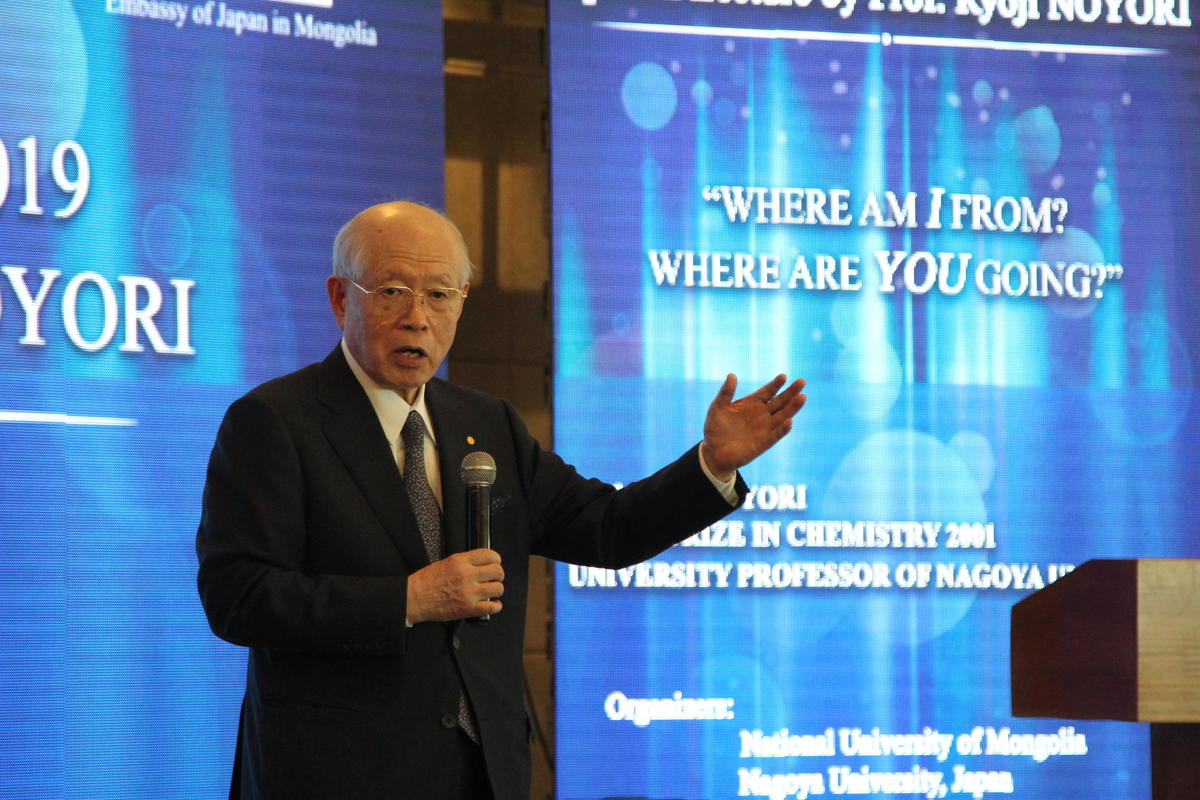 Prof. Noyori giving a special lecture in Ulaanbaatar
Prof. Noyori giving a special lecture in Ulaanbaatar
Noyori was also touched by this youthful enthusiasm at NUM, Gal-san's alma mater. It was founded in 1942 as the first university in Mongolia, and is known to be the hardest school to get accepted to in the country. Up till now it has been ranked as an institution of higher education, but the government has introduced a policy to convert four universities into research universities, and as the top school on that list, they are now seeking support from Meidai to create a system. NUM entered into an academic exchange agreement with Meidai in 2006, and after Meidai President Seiichi Matsuo paid the school a courtesy visit last autumn, in March of this year NUM president Tumurbaatar Yadmaa visited Meidai to see the school and exchange ideas. After strong demand from NUM, it was decided that Noyori would visit as the representative researcher for Japan.
Noyori met with Gombojavyn Zandanshatar, Chairman of the State Great Khural, and Education, Culture, Science and Sports Minister Yondonperenlei Baatarbileg, and then gave a speech titled "Where Am I From? Where Are You Going?" The visit continued as two young researchers from Meidai joined in for an exchange of ideas with youth from Mongolia. Noyori spoke about how, as science and technology have become globally competitive, cooperation is indeed important to pave the way towards the future, and gave words of encouragement to the younger generation that will shoulder this task.
After his first visit to Mongolia, Noyori spoke of his impressions and hopes, saying, "The youthfulness was impressive. I think there is certainly potential for new things to emerge from Mongolia. I want the opportunity of this visit will lead to expand exchanges with each other."
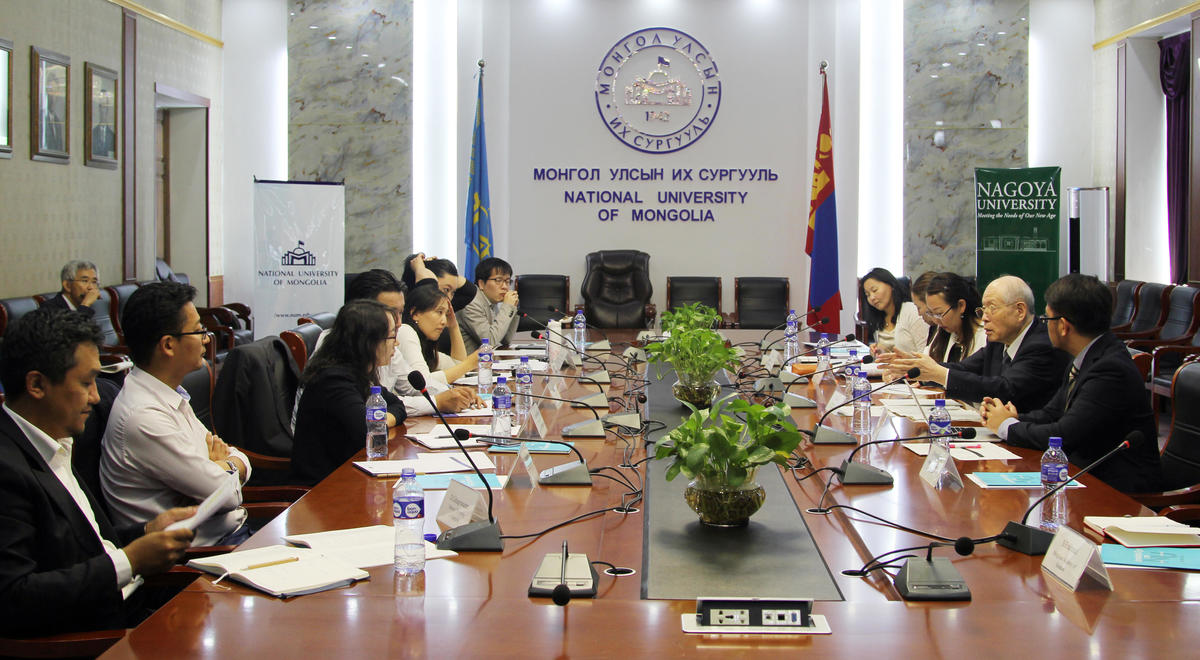 In addition to young researchers from Mongolia’s top universities and research institutions, Designated Lecturer Atsushi Nishizawa from Meidai’s Institute for Advanced Research and Associate Professor Ryohei Sasano from the Graduate School of Informatics
In addition to young researchers from Mongolia’s top universities and research institutions, Designated Lecturer Atsushi Nishizawa from Meidai’s Institute for Advanced Research and Associate Professor Ryohei Sasano from the Graduate School of Informatics
Mongolia is one of the countries in Asia that Meidai researchers have connections with in a wide variety of fields. The Japanese Law Education Research Centre was established at NUM in 2006 to teach Japanese law in Japanese. It was followed by the Cooperative Center for Resilience Research in 2016, which does interdisciplinary research and education in the fields of disasters and the environment, and is developing various activities including education for disaster risk reduction. In the Asian Satellite Campuses Institute's Transnational Doctoral Programs for Leading Professionals in Asian Countries, there are also students studying in fields like law, medicine and environmental studies, in addition to the education studies that Gal-san is participating in.
NUM wants to offer research and education of an international level. In working towards that dream they have high expectations for Meidai, which has produced a large number of Nobel Laureates. But establishing a research university is not easy. Meidai is also trying to transform itself as a university. I'd like Meidai to utilize its knowledge and experience to search for a form of support that only Meidai can offer.
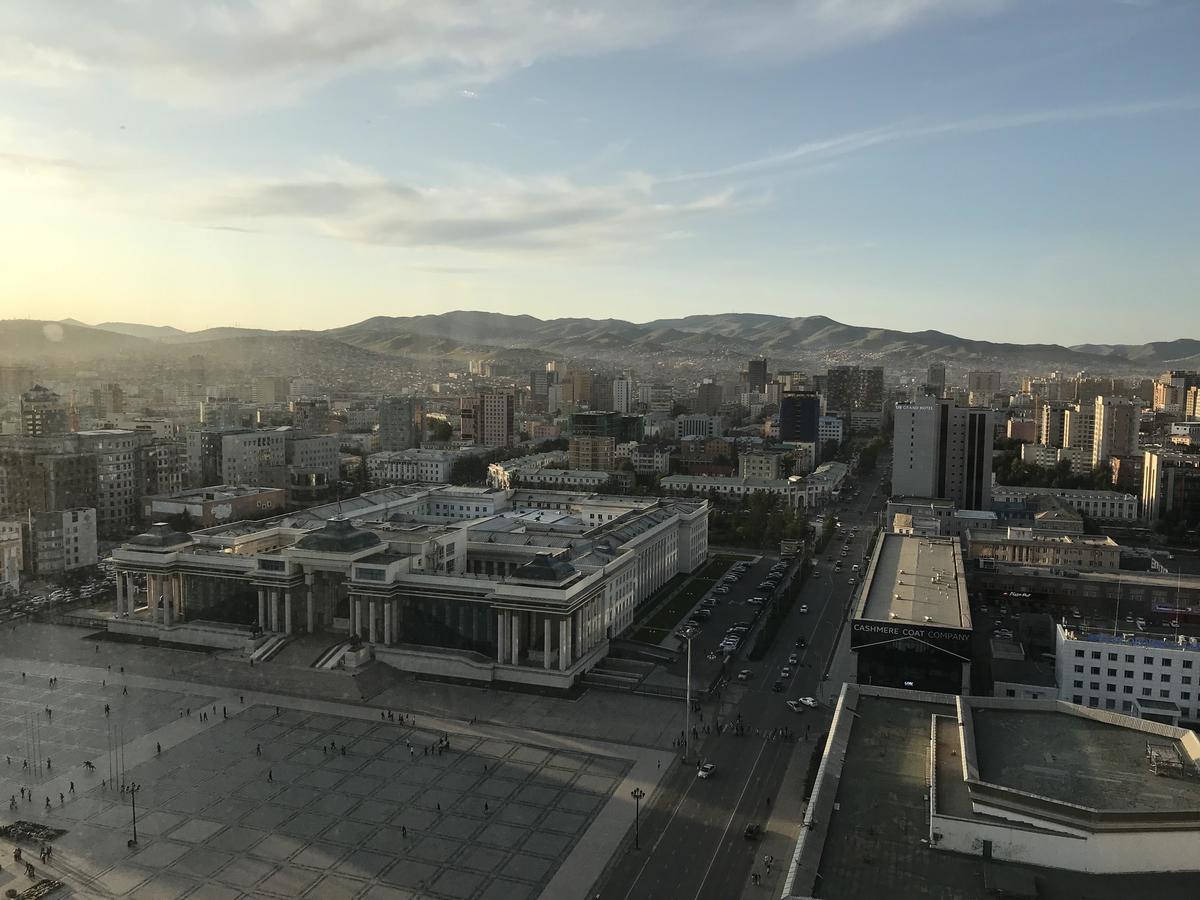 The government palace at the center of Ulaanbaatar. At the front entrance stands a statue of Ghengis Khan, respected and adored by residents. Across the street on the right and go further, you will find NUM.
The government palace at the center of Ulaanbaatar. At the front entrance stands a statue of Ghengis Khan, respected and adored by residents. Across the street on the right and go further, you will find NUM.

 Subscribe to RSS
Subscribe to RSS